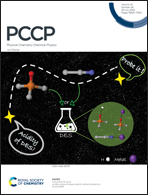Heteroleptic Cu(i) bis-diimine complexes as sensitizers in dye-sensitized solar cells (DSSCs): on some factors affecting intramolecular charge transfer†
Abstract
A set of eight heteroleptic bis-diimine copper dye complexes with two different ancillary ligands (functionalised 2,9-dimethyl-1,10-phenanthroline (dmp) and functionalised 6,6′-diphenyl-2,2′-bipyridine (dpbpy)) are investigated for their potential use as sensitizers in dye-sensitized solar cells (DSSCs), using first principles density functional theory (DFT) and time dependent DFT (TDDFT). A detailed analysis of the structural properties, projected density of electronic states and Kohn–Sham energy levels, and optical absorption spectra in the UV-visible region reveals that substituting the thiophene group in the ancillary ligand, and enhancing conjugation in the anchoring ligand, lead to increase in the light harvesting efficiency (LHE). However, a natural transition orbital (NTO) analysis, shows that the nature of charge transfer depends mainly on the nature of the parent ancillary group and is not significantly affected by the structural modifications. Importantly, the lower energy excitations lead to favourable mixed metal to ligand charge transfer (MLCT) and ligand to ligand charge transfer (LLCT), as well as good electron injection. The best charge transfer directionality is found in the dmp-based dyes, particularly thiophene substituted dyes, thus making these the more effective sensitizers in DSSCs.



 Please wait while we load your content...
Please wait while we load your content...